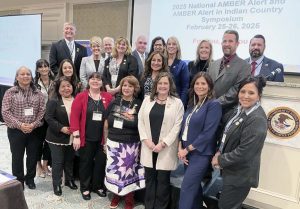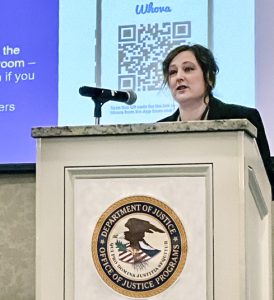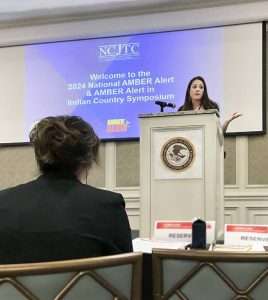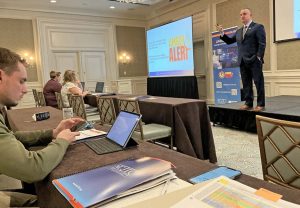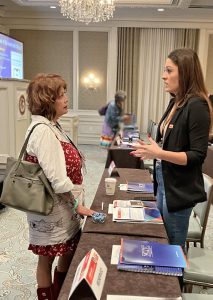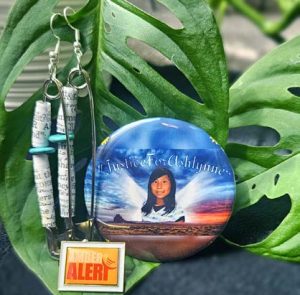By Denise Gee Peacock
Hundreds of state and regional AMBER Alert Coordinators, Missing Person Clearinghouse Managers, Tribal law enforcement officers, public alerting/emergency management experts, and federal officials gathered in New Orleans February 27–28 to attend the 2024 National AMBER Alert and AMBER Alert in Indian Country Symposium.
 The no-fee training and collaborative learning event, funded through the U.S. Department of Justice, Office of Justice Programs, and administered by the AMBER Alert Training and Technical Assistance Program (AATTAP), engaged attendees in discussing developing trends and case studies, sharing best practices, and training with other child protection partners to better respond to endangered missing and abducted child cases.
The no-fee training and collaborative learning event, funded through the U.S. Department of Justice, Office of Justice Programs, and administered by the AMBER Alert Training and Technical Assistance Program (AATTAP), engaged attendees in discussing developing trends and case studies, sharing best practices, and training with other child protection partners to better respond to endangered missing and abducted child cases.
Held at the historic Hotel Monteleone in New Orleans’ French Quarter, the Symposium featured 26 workshops led by dozens of subject-matter experts as well as three keynote speakers. It also included six regional and Tribal breakout sessions that allowed for in-depth discussions on issues of importance to their states and Tribes.
Amanda Leonard, Coordinator for the Missing Child Center-Hawaii/Department of the Attorney General, flew more than 4,200 miles to attend the Symposium with Honolulu Police Department Detective William “Billy” Oku.
“The survivors and trainers at this event give us the needed reminder of why we serve as AMBER Alert Coordinators,” Leonard said. “It’s an incredible opportunity to excel in our important collective work. One team, one fight!”
AATTAP Administrator Janell Rasmussen welcomed hundreds of participants representing nearly every state in the nation, as well as the program’s Northern Border Initiative partner, Canada.
In crediting the grant support that the AATTAP and its AMBER Alert in Indian Country (AIIC) Initiative receives from the Office of Juvenile Justice and Delinquency Prevention (OJJDP), Rasmussen recognized two OJJDP attendees—AATTAP Grant Manager Alex Sarrano, and Lou Ann Holland, Grant Manager for the National Center for Missing & Exploited Children (NCMEC), “for their dedication to protecting children, and their passion for the work being done” by those at the Symposium.
Rasmussen praised attendees’ “hard work—work most people could not do—on behalf of missing children. Many of them are home today, but some are not. Let’s remember Elijah Vue in Wisconsin, Morgan Nick in Arkansas, Mikelle Biggs in Arizona, and Navaeh Kingbird in Minnesota. These children and so many others deserve to be found, to be reunited with their families, and to grow up in a safe environment.”
Training ‘for you, by you’
The AATTAP team develops and delivers training opportunities crafted “for you, by you”—and each Symposium is the standard bearer of that.
“ ‘For you, by you’ isn’t just a catchphrase—it’s our guiding principle,” said Byron Fassett, AATTAP Deputy Administrator. “Everything on the agenda is the result of our team asking everyone at last year’s Symposium—and everyone who participated in hundreds of our classes since then—‘What do you want to see?’ and ‘What are your needs?’”
Additionally, Symposium-goers had a digital, interactive tool for planning, collaborating, and providing feedback: the event app Whova. The platform let participants review the agenda, plan for sessions they wished to attend, map out class locations, check into sessions, weigh in on discussion topics, connect for lunch or dinner, share photos, and much more. Attendees also could suggest topics and locations for next year’s Symposium.
Guest speaker Brad Russ, Executive Director of the National Criminal Justice Training Center (NCJTC) of Fox Valley Technical College (FVTC), said he was proud to see how far training topics and techniques have advanced from what he experienced during his early days in law enforcement in New Hampshire.
Russ’s respected work would ultimately lead the OJJDP to seek his involvement in nationwide training that began more than 30 years ago. During that time, missing child advocate Patty Wetterling of Minnesota “helped open the eyes and hearts of stoic police officers with her powerful insight into what parents face when their child goes missing,” he recalled.
Russ also commended an early mentor—OJJDP/FVTC instructor and retired Pennsylvania Police Sergeant Gary O’Connor—for advancing traditional training techniques that historically involved staid presentations full of statistics into curriculum and instructional design employing more dynamic approaches, such as engaging participants through robust discussions, knowledge checks, and tabletop exercises. Russ has ensured such effective strategies have carried forward since the NCJTC’s creation in 2009.
The power of family perspectives

Symposium attendees received copies of the newly updated resource, When Your Child Is Missing: A Family Survival Guide. They also learned about its companion website, which gives caregivers and law enforcement instant access to the Guide’s multimedia content, including videos of the parent-survivors sharing powerful stories and advice.
“When we released the Guide on Missing Children’s Day 2023, the families involved in its production joined us for a meeting with OJJDP Administrator Liz Ryan and her team,” said AATTAP Administrator Rasmussen. “The parent-authors were adamant that law enforcement needed more guidance on how to best work with, and understand, families of missing children. They also emphasized that missing child cases, and relevant training, should be a priority for law enforcement.”
As a result, Ryan asked the AATTAP to help update the resource guide, What About Me? Coping With the Abduction of a Brother or Sister. “Siblings of missing children often suffer in silence, but need so much support,” Rasmussen said.
Two family members who are helping produce the new sibling guide served as keynote speakers for the Symposium.
Kimber Biggs spoke about the devastating loss of her 11-year-old sister, Mikelle Biggs. On January 2, 1999, Mikelle was abducted while riding her bike near her family’s Arizona home—and never seen again. Biggs was 9 years old when that trauma took place, but she has spent 25 years advocating on her sister’s behalf. She now works as an Associate with the AATTAP-NCJTC.

Biggs shared several distressing interactions with law enforcement “that I hope you all can learn from.” The biggest blow, she said, was set in motion after detectives learned that her father was having an affair at the time of her sister’s disappearance.
“And instead of looking at other suspects—including a registered sex offender on our street—they fixated on my dad and the affair. That was a huge setback for the case,” Biggs said. “Their thinking that he was guilty of harming my sister only added to our family’s trauma.”
While it’s taken more than two decades to see renewed interest “in what was a very cold case,” a new detective has been assigned to it, Biggs said. “That’s a great relief. It’s nice to have someone now who is trustworthy and proactive. We communicate at least weekly. And the fact that he’s eyeing a significant suspect in the case makes it feel like something is finally happening.”
On the Symposium’s second day, Pamela Foster shared her powerful story. Foster is the mother of the late 11-year-old Ashlynne Mike, whose May 2016 abduction and murder on the Navajo Nation in New Mexico led to Foster becoming a self-described “warrior mom”—not only for her daughter, but for all children in Indian Country.
“Words cannot describe the brokenness I felt when I learned Ashlynne had been murdered,” Foster said. “Words cannot describe the sheer anguish my family and the community felt at the sudden death of our precious little girl. A deep heartache followed.”
 Her anguish would be further heightened after learning that the Navajo Nation—the nation’s largest Indian reservation, spanning three states—was not equipped to quickly issue an AMBER Alert. And confusion by outside law enforcement over who had the proper jurisdiction to issue the alert created a major delay in finding Ashlynne.
Her anguish would be further heightened after learning that the Navajo Nation—the nation’s largest Indian reservation, spanning three states—was not equipped to quickly issue an AMBER Alert. And confusion by outside law enforcement over who had the proper jurisdiction to issue the alert created a major delay in finding Ashlynne.
“Within weeks, I started petitions to bring the AMBER Alert to Indian Country,” she said. “I called for action from my friends, the Navajo Nation, and the federal government. And though I was physically exhausted and spiritually broken, I poured my heart into effecting legislative change.”
With the support of late U.S. Senator John McCain and Representative Andy Biggs, both of Arizona, by 2018, the Ashlynne Mike AMBER Alert in Indian Country Act was signed into law—and ultimately lead to the creation of AATTAP’s AMBER Alert in Indian Country Initiative. “I’m always reassured whenever I see an AMBER Alert doing what it’s supposed to do,” Foster said.

After Foster’s talk, AATTAP Administrator Rasmussen and AIIC Program Manager Tyesha Wood presented her with a gift “in recognition of her ongoing bravery, generosity, and never-ending commitment to moving AMBER Alert in Indian Country initiatives forward in memory of Ashlynne—and all missing children,” Rasmussen said. “Pamela’s tireless work has changed the way we respond to missing children in Indian Country. Today, the Navajo Nation has an AMBER Alert Plan, and many other Tribal nations are working with state and regional partners to ensure that what happened to Ashlynne never happens again.”
“As painful as Kimber and Pamela’s experiences are to hear, it’s important that we do hear them to help improve our response,” said keynote speaker Marlys Big Eagle. A member of the Crow Creek Sioux Tribe in South Dakota, Big Eagle serves as the National Native American Outreach Services Liaison for the U.S. Department of Justice, and has worked in criminal justice for more than two decades. Her work centers on the Missing and Murdered Indigenous Persons (MMIP) Initiative and other public safety issues in Indian Country.
Over and out—and energized
At the conclusion of the Symposium, Rasmussen reminded attendees of what family members of missing children said after finalizing their work on the Family Survival Guide. “When we asked them, ‘If you could tell law enforcement what they need to hear, what would you say? ’ One of the parents mentioned earlier, Patty Wetterling, said, ‘We know the work that you do is hard; that you have families to go home to; that the work you’ve done during the day remains with you. But remember: We’re suffering the most horrific event of our lives. So we’re counting on you to do everything possible to bring our child home. But also know that we thank you for everything you do.’”
These and other words of advice and encouragement bolstered conversations long after the Symposium ended. Using the Whova app, attendees could continue discussing how to fund new technology; start and sustain a CART; improve leads management; navigate the changing social media landscape; adapt to the growing number of emergency alert classifications; develop ways to capture data; and keep people properly trained during staffing shortages. They also used the Whova platform to provide important feedback for next year’s Symposium.
Calling the conference “one of the most outstanding ones to date,” Hawaii’s AMBER Alert Coordinator Amanda Leonard also shared this: “On my way home to Honolulu via Houston, as soon as the plane landed, I received an AMBER Alert for a 12-year-old girl abducted in the city. I felt so connected to the Texas law enforcement team working her case and helping her terrified loved ones. The work never ends—and abducted children need us to be prepared to issue a lifesaving AMBER Alert for them.”

Save the date—and share your successes!
〉 Next year’s Symposium is planned for Feb. 25–26, pending DOJ funding and event approval. (Stay tuned for the location.) “We already have exciting things planned for it,” said Janell Rasmussen, AATTAP Administrator. “One is to formally recognize the exceptional work of an AMBER Alert Coordinator, Missing Persons Clearinghouse Manager, or CART Coordinator.”
〉 Share your team’s success stories by emailing us at askamber@fvtc.edu.

